Medical Terminology
An Illustrated Guide
th edition Barbara Janson Cohen, MEd Ann DePetris, MSA, RN, CCRP
 Senior Acquisitions Editor:
Senior Acquisitions Editor: Jonathan Joyce
Product Development Editor: Staci Wolfson
Editorial Assistant: Tish Rogers
Marketing Manager: Leah Thomson
Production Project Manager: Priscilla Crater
Design Coordinator: Terry Mallon
Art Director: Jennifer Clements
Manufacturing Coordinator: Margie Orzech
Prepress Vendor: Aptara, Inc. 8th edition Copyright 2017 Wolters Kluwer. Copyright 2014 Lippincott Williams & Wilkins, a Wolters Kluwer business. All rights reserved. This book is protected by copyright. No part of this book may be reproduced or transmitted in any form or by any means, including as photocopies or scanned-in or other electronic copies, or utilized by any information storage and retrieval system without written permission from the copyright owner, except for brief quotations embodied in critical articles and reviews.
Materials appearing in this book prepared by individuals as part of their official duties as U.S. government employees are not covered by the above-mentioned copyright. To request permission, please contact Wolters Kluwer at Two Commerce Square, 2001 Market Street, Philadelphia, PA 19103, via email at (products and services). 9 8 7 6 5 4 3 2 1 Printed in China Library of Congress Cataloging-in-Publication Data Cohen, Barbara J., author. Medical terminology : an illustrated guide / Barbara Janson Cohen, Ann DePetris. p.; cm. p.; cm.
Includes bibliographical references and index. ISBN 978-1-4963-1888-6 (alk. paper) I. DePetris, Ann, author. II. [DNLM: 1. [DNLM: 1.
Terminology as Topic. W 15] R123 610.14dc23 2015036947 DISCLAIMER This work is provided as is, and the publisher disclaims any and all warranties, express or implied, including any warranties as to accuracy, comprehensiveness, or currency of the content of this work. This work is no substitute for individual patient assessment based upon healthcare professionals examination of each patient and consideration of, among other things, age, weight, gender, current or prior medical conditions, medication history, laboratory data and other factors unique to the patient. The publisher does not provide medical advice or guidance and this work is merely a reference tool. Healthcare professionals, and not the publisher, are solely responsible for the use of this work including all medical judgments and for any resulting diagnosis and treatments. Given continuous, rapid advances in medical science and health information, independent professional verification of medical diagnoses, indications, appropriate pharmaceutical selections and dosages, and treatment options should be made and healthcare professionals should consult a variety of sources.
When prescribing medication, healthcare professionals are advised to consult the product information sheet (the manufacturers package insert) accompanying each drug to verify, among other things, conditions of use, warnings and side effects and identify any changes in dosage schedule or contraindications, particularly if the medication to be administered is new, infrequently used or has a narrow therapeutic range. To the maximum extent permitted under applicable law, no responsibility is assumed by the publisher for any injury and/or damage to persons or property, as a matter of products liability, negligence law or otherwise, or from any reference to or use by any person of this work. LWW.com For all his continued personal and professional support over so many years, I dedicate this 8th edition of Medical Terminology: An Illustrated Guide, to my husband, Matthew Jarvis Cohen. Barbara Cohen To my husband Michael and my children, Drs. Bob and Marie Howard, Paul and Maria DePetris, for their unrelenting support and patience; to Shirley Wells and Dr. Janice Griffin for their continued encouragement and love; and to Barbara Cohen without whose commitment and guidance this would not have been possible.
Its to all of you I dedicate this edition. Ann DePetris

Preface
K nowledge of medical terminology is fundamental to a wide variety of healthcare fields. This book is designed to satisfy the basic learning requirements needed to practice in any health career setting. In the course of your training and future careers, you will need to learn thousands of new terms. The job might be overwhelming if not for learning the skills of dividing the words into their component parts. These roots, suffixes, and prefixes appear over and over in different terms but retain the same meanings.
Knowing these meanings will help you define and remember a host of words. This process is like using a set of building blocks to assemble different structures. Using a more scientific example, its like using the four bases in DNA to code for all the amino acids needed to make proteins. After the introductory sections, each chapter begins with an illustrated overview of a specific body system with definitions of the key terms related to that system. Tables of word parts and exercises on using them follow. Turning to the abnormal, a section on diseases and treatments is included, followed by definitions of relevant key terms.
The section of supplementary terms includes words and phrases that are good to know if time allows or if someone is particularly interested in that specialty. The sequence of the systems chapters differs slightly from that found in traditional anatomy and physiology books. The organization emphasizes their clinical importance, starting with the cardiovascular, respiratory, and digestive systems and continuing with systems treated in more specialized fields, such as the urinary, reproductive, and musculoskeletal systems. The chapters can be taken out of order once the introductory units are completed. We have tried to make this book easy to use and full of reinforcing drills. We have also included many phonetic pronunciations so you can recognize technical terms when they are spoken and can comfortably use them yourself.
The online student learning resources offer many additional activities and an audio glossary. Each chapter is enlivened with a short opening case study. These may have some words and abbreviations that are unfamiliar to you, especially at the start of the book. They are included to spark your interest in the chapter material, and give you a sense of medical situations and language. Dont be concerned if you dont understand them completely. Return to them after you study the chapter, or even later chapters, and see if they are more understandable.
You are probably at the beginning of a long journey to gain accomplishment in your chosen field. We hope that this book will aid you in that endeavor and provide a basis on which to build your career. Barbara CohenAnn DePetris

Acknowledgments
I n our constant quest to improve the quality of
Medical Terminology: An Illustrated Guide, we rely on the advice and talents of many people. First, we want to acknowledge the observant instructors and students who take the time to suggest improvements in the text. Also we thank the reviewers, who make many valuable suggestions for revisions. The clinicians who contributed current information in their respective fields include Margaret O.

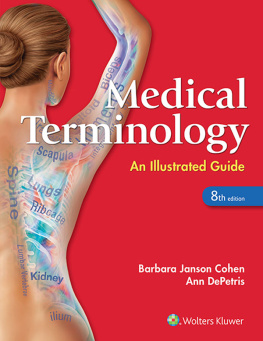
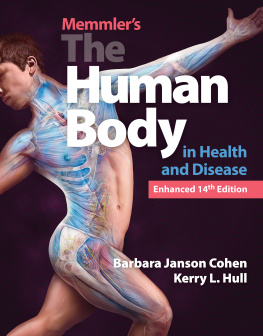


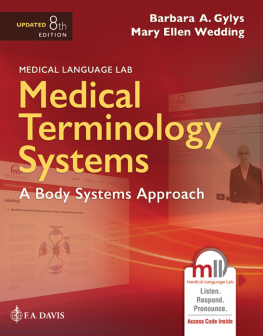

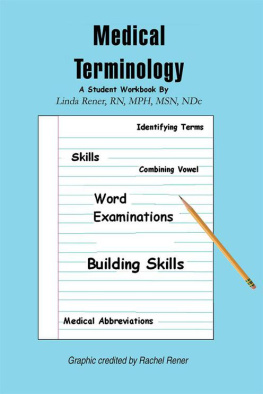


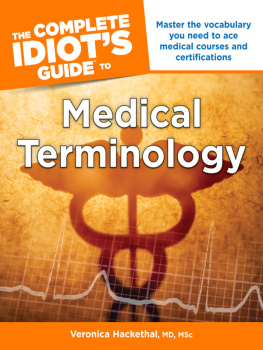
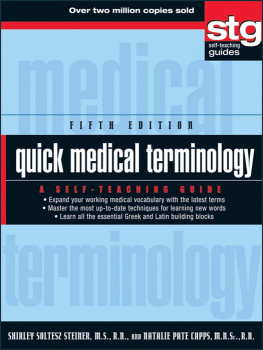
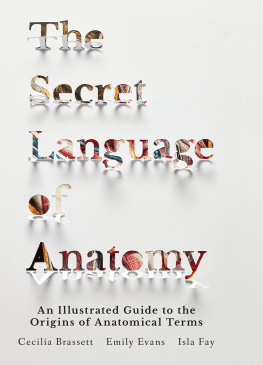

 Senior Acquisitions Editor: Jonathan Joyce Product Development Editor: Staci Wolfson Editorial Assistant: Tish Rogers Marketing Manager: Leah Thomson Production Project Manager: Priscilla Crater Design Coordinator: Terry Mallon Art Director: Jennifer Clements Manufacturing Coordinator: Margie Orzech Prepress Vendor: Aptara, Inc. 8th edition Copyright 2017 Wolters Kluwer. Copyright 2014 Lippincott Williams & Wilkins, a Wolters Kluwer business. All rights reserved. This book is protected by copyright. No part of this book may be reproduced or transmitted in any form or by any means, including as photocopies or scanned-in or other electronic copies, or utilized by any information storage and retrieval system without written permission from the copyright owner, except for brief quotations embodied in critical articles and reviews.
Senior Acquisitions Editor: Jonathan Joyce Product Development Editor: Staci Wolfson Editorial Assistant: Tish Rogers Marketing Manager: Leah Thomson Production Project Manager: Priscilla Crater Design Coordinator: Terry Mallon Art Director: Jennifer Clements Manufacturing Coordinator: Margie Orzech Prepress Vendor: Aptara, Inc. 8th edition Copyright 2017 Wolters Kluwer. Copyright 2014 Lippincott Williams & Wilkins, a Wolters Kluwer business. All rights reserved. This book is protected by copyright. No part of this book may be reproduced or transmitted in any form or by any means, including as photocopies or scanned-in or other electronic copies, or utilized by any information storage and retrieval system without written permission from the copyright owner, except for brief quotations embodied in critical articles and reviews.  Preface
Preface